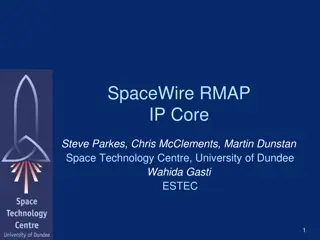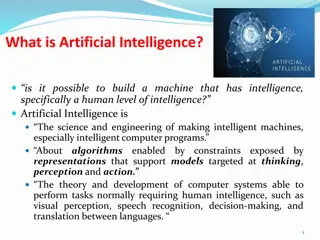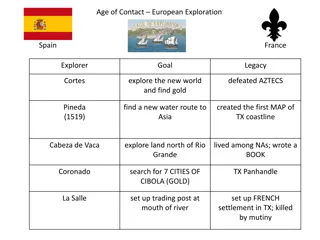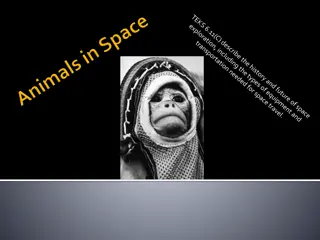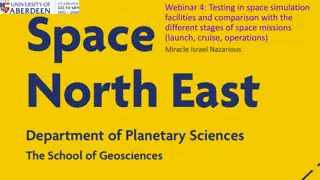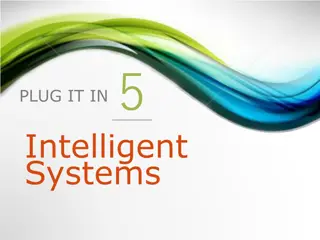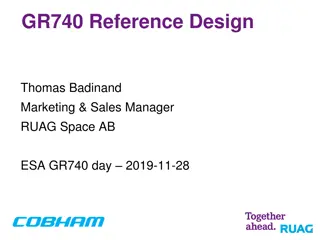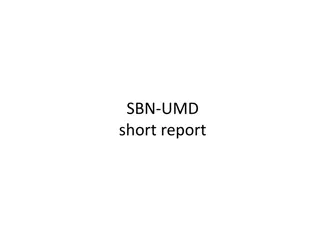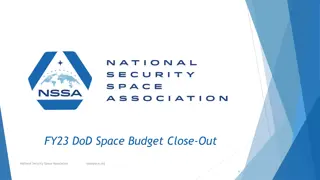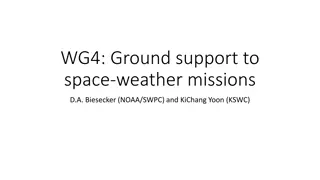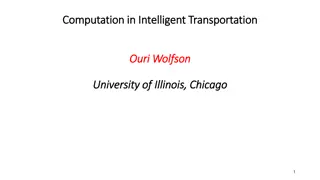Intelligent Control Applications in Industry and Space Missions
This content discusses the applications of intelligent control in industry and its adaptation to space missions, highlighting the core competencies of sensor fusion, automatic data analysis, and real-time surveillance. It delves into Knowtion's expertise in sensor data processing, specialized algorithms for air traffic control systems, and medium-term conflict detection to enhance aviation safety and efficiency.
Download Presentation

Please find below an Image/Link to download the presentation.
The content on the website is provided AS IS for your information and personal use only. It may not be sold, licensed, or shared on other websites without obtaining consent from the author.If you encounter any issues during the download, it is possible that the publisher has removed the file from their server.
You are allowed to download the files provided on this website for personal or commercial use, subject to the condition that they are used lawfully. All files are the property of their respective owners.
The content on the website is provided AS IS for your information and personal use only. It may not be sold, licensed, or shared on other websites without obtaining consent from the author.
E N D
Presentation Transcript
Applications of Intelligent Control in Industry and Adaption to Space Missions Vesa Klumpp, Knowtion 2017-11-24
About Knowtion Founded in April 2011 Close contact to Karlsruhe Institute of Technology Customer-specific software and algorithm development Customer-oriented problem-solving approach with scientific background Karlsruhe Highly qualified engineers and computer scientists with special knowledge in sensor fusion and data analysis 2
Core Competencies Sensor Fusion Combination of different sensor data and information sources Automatic Data Analysis Realtime surveillance of sensor data and detection of anomalies 3
Core Competencies Raw sensor data Information Model / Algorithms Temperature Pressure Acceleration Position Sensor Fusion (Bayes) Classification Machine Learning Deep Learning Approaches Reduced systematic error Filtered Plausible Data reduction Accuracy estimate Extracted information Plausible data Filtered data 4 4
Air Traffic Control 1/3 Surveillance data processing system (tracker) Wanted Current air situation picture (position and velocity of each aircraft) Given Disturbed measurements of multiple radar stations Different types of sensor technologies (PSR, SSR, ADS-B, MLAT) 5
Air Traffic Control 2/3 Solution Specialized algorithms for Data association Track update Result Plausible tracks with high accuracy Simultaneous monitoring of sensors 6
Air Traffic Control - other projects 3/3 Medium term confliction detection Warn the controller of potential conflict between flights in his area of responsibility Departure and arrival flow management Optimization of departure and arrival sequences under several time and spatial constraints Proposal of actions for air traffic controllers 7
Hot Water Tank Wanted h=0 mm top h=150 mm TTR1 Temperature and energy profile Detection of warm water draw off h=524 mm Supply of hot water on demand h=624 mm TTR2 Solution h=804 mm TSolIn h=1036 mm Algorithm for temperature profile reconstruction and energy estimation h=1268 mm Learning of user behavior over time to provide heat in advance and reduce energy consumption TSolOut h=1484 mm Limited main memory: 5 kB 8
Extrusion Foaming Process Production of construction material for thermal insulation (Extruded polysterene foam, XPS) Health monitoring of production process Prediction of final production quality Optimization and control of extruder and machine parameters Prediction of quality of final product Control Algorithms Process and machine data Sensor data Intermediate Product Extruder Final Product 9
Flight Passenger Number Prediction Wanted Prediction of PAX for each flight within the next 2 months Given Historic passenger data of the last years Solution Application of of multiple machine learning algorithms (Ensemble) Achieved performace similar to human expert 10
Anominer - Overview Automatic monitoring of data for changes, outliers, and anomalies Learning and analysis of process data in real-time Machine learning and deep learning algorithms For automated inspection of process data, customer-specific adaption possible Outlier detection Detection of anomalies 11
Anominer - Filling Plant Monitoring of a bottle filling process for detection of leakages and errors 1ststep Learning : Anominer accepts input data streams and learns normal behavior of data in real-time 2ndstep Evaluation : Anominer monitors input data streams for changes Result is an anomaly indicator that describes the deviation of the learned normal behavior Fast response: Result is returned in real-time 12
Anominer DC Motor Monitoring of the health of a DC motor Change of input data is very subtle when defect is present (e.g. change in friction, inductivity, or electrical resistance of rotor) Same setup and configuration of Anominer as in filling plant use case Anominer can also be employed to detect very subtle changes in input data 13
High Altitude Test and Validation Service employing SpaceFish Vehicle Successor of GSTP 4 activity Integrated Vehicle Health Management System Demonstrator (iHMSD) High-altitude re-entry demonstrator space vehicle Glider is equipped with payload, e. g. measurement equipment Glider is dropped from balloon and shall return to specific location autonomously Challenges: Unknown payload changes flight behavior Intelligent monitoring of system 14
Intelligent Flight Control Algorithm General Requirements: Online / Real-time learning and evaluation Relatively low processing power available Low communication bandwidth and high latency to base station Offloading of processing to base station probably not feasible 15
Intelligent Flight Control Algorithm Sensors measure current flight path Model predicts behavior of glider Based on equation of motion or learned Current flight path is evaluated/scored Smoothness, deviation from planned trajectory, Intensity of control On-line learning of flight characteristics Adaption of control strategy 16
Approaches for Complexity Reduction Pre-trained models Offline learning from recordings and online update Reduced state space for lower computational complexity Lower-dimensional parameterization of model Conditional models Decomposition of problem Use set of motion equations for different flight maneuvers or learn different parts of trajectory Learning is re-weighting of single models 17
System/Health Monitoring Sensor faults On-line estimation of calibration Flight dynamics, mechanical structure, vibrations Find specific signals or features in sensor data Controller performance Evaluate settling time, extent of control variables Decreased performance may indicate problem 18
System/Health Monitoring Detection of deviations from normal behavior Employ pre-trained model or learn online during flight On-line evaluation Potential Processing Pipeline Onboard pre-processing and data reduction Detection of faults with machine learning algorithms in base station 19
Thank you for your attention! www.knowtion.de team@knowtion.de +49 721/486 995-10 20
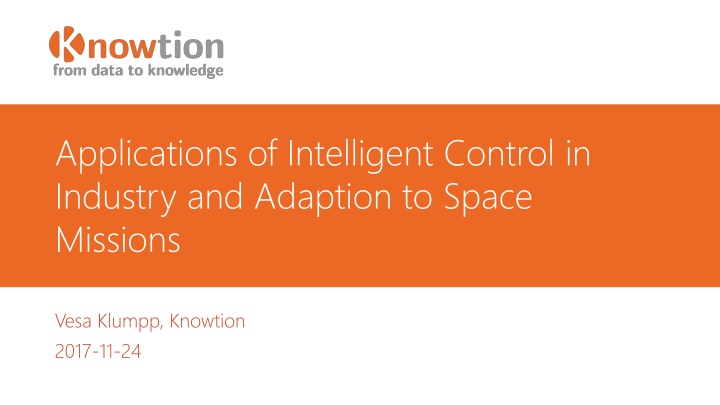

![Read⚡ebook✔[PDF] The Untold Stories of the Space Shuttle Program: Unfulfilled D](/thumb/21685/read-ebook-pdf-the-untold-stories-of-the-space-shuttle-program-unfulfilled-d.jpg)



